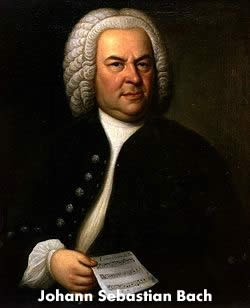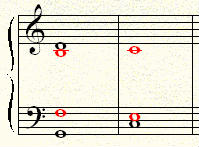How Bach Used the "Devil's Music"
 During the middle of the sixteenth century, there was intense debate about music in the church. Several issues were on the table:
During the middle of the sixteenth century, there was intense debate about music in the church. Several issues were on the table:
- The use of specific instruments
- Polyphony. Polyphony refers to music that has two or more separate melodic lines (voices). Before polyphony, music was monophonic (consisting of only a single voice or melody line and no harmony).
- Dissonance in music
- Questionable rhythms
- Excessive technical ornamentation (referring to musicians who showed off their ability a little too much)
The setting for this debate may surprise you. No, the meeting was not among Reformers. Actually, this dialogue took place between conservatives and progressives of the Catholic Church during the Council of Trent.
During this same time, Luther and Calvin were teaching their own musical convictions to their followers. Luther was a music progressive who pushed for innovation in music in areas such as polyphony. He liked instruments in the church (except for organs) and hated what we would call “high church music.” On the other hand, Calvin was a music conservative who rejected the use of instruments in the church and refused to allow polyphony. (Information in preceding paragraphs is from Douglass Seaton, Ideas and Styles in the Western Music Tradition [New York: McGraw-Hill, 2005], 151-160.)
As you can see, music wars between conservatives and progressives within the church are nothing new. In fact, it is interesting to note that some of the same specific issues are still being debated five centuries later.
Many of us would do well to study the history of Western music. That advice is especially true for those who insist on taking dogmatic and/or extreme positions. We have a lot to learn from the past, and I want to reflect on a few thoughts in particular that I find relevant to where we are as a movement today. Unity is not the goal—we all know that is impossible with this issue. Thoughtful introspection, however, is a worthy goal for each of us
Before I start, I want to mention that my references to “conservatives” and “progressives” are on purpose, but not intended to be polarizing or offensive. They are simply the best words I can use to describe the two sides of this issue throughout history. Conservatives have been slow to accept innovation in music while progressives have embraced innovation.
To begin, here is a quick synopsis of the development of Western music. We can trace the origin back to ancient Greece and the writings of such philosophers as Plato and Aristotle. In those days, music was monophonic (single melody line without harmony).
Over the next fifteen hundred years, music developed slowly but steadily. Gradually, simple polyphony was introduced, and the music became more structured. By the time Bach was born, polyphonic music was quite advanced, and Bach built on the foundation of several ingenious composers who preceded him.
After Bach, music continued to develop and has continued to evolve to this day. Some people (including Wagner) have tried to claim that music hit a pinnacle at some point between Bach and Beethoven, but that is a very naive position. Even though we might not prefer certain aspects of modern music, such as its unique form and dissonance, knowledgeable musicians would find it hard to deny that music has advanced in many ways since the baroque and classical eras.
An uneasy tension has existed between the church and musical progress for many centuries. Even outside the church, there has been intense debate between conservatives and progressives. Schumann wrote about this tension in 1834:
Like political parties, one can divide musical parties into liberals, moderates, and conservatives or into Romantics, Moderns, and Classicists. On the right sit the elders, the contrapuntists, the promoters of early music … ; on the left, the youths, … the despisers of form, the bold originals, among whom the Beethovenians stand out as group. (Seaton, 354-355)
This quote is quite interesting because it demonstrates how positions have changed over the years. In 1834, Beethoven represented the liberals, while the baroque and classical periods were considered conservative. However, baroque music had been considered liberal only a few centuries before. And, of course, only the most extreme conservative today would claim that Beethoven music is liberal.
Historically, music development has occurred faster when progressives have had more influence, but that is not to say that conservatives have not produced great music. For example, music from both the progressive Lutheran movement and the conservative Calvinist movement has survived into the twenty-first century.
It is very clear that throughout history conservatives have had a problem determining what characteristics church music should have. By way of example, I will talk about dissonance in music and, more specifically, an interval called the tritone.
Many music historians would say that the development of music can be summarized as an evolving acceptance of dissonance. Dissonance refers to the use of harmony that sounds discordant and in need of resolution. During the early periods, dissonance was not even possible because the music was monophonic. However, over time and to the dismay of conservatives, dissonance was slowly introduced into music. Today, our Western ears expect and welcome dissonance. In fact, it is hard to imagine music without it.
One dissonant interval the church rejected was the tritone. The tritone, an interval made from three whole steps, sounds very dissonant. In fact, this interval had a nickname that is translated “the Devil in music.” It was forbidden in church music for centuries.
As it turns out, the tritone is actually a very important interval for many reasons that are too technical to go into in this article. However, one of the most important functions of the interval is its presence in the V7–I cadence that we find in almost every hymn we sing. Here is an example of how the tritone works in the cadence. Notice how the two notes in the interval (marked in red) resolve naturally to the tonic chord.
By the time Bach was writing music, conservatives were losing the battle over the tritone. Bach used it in certain situations, and eventually it became even more acceptable. Today, it is a natural and expected component of our music. Even the most conservative among us have no problem with the “Devil’s interval.”
I was recently discussing this issue with a musical scholar, and he asked why the tritone is acceptable in church today but wasn’t in the fifteenth century? Did God change His mind at some point, or was the church’s position on the tritone a baseless one? Or perhaps we need to get rid of tritones and revert to pre-Bach music?
I think we all know the answers to those questions, and those answers lead us to the obvious next question. Are there man-made music standards in our belief system today that are someday going to look as silly as the tritone controversy looks to us?
As a musician whom most would consider to be quite conservative, these kinds of questions make me uncomfortable. It is clear to me that there are things about some of today’s Christian music that conflict with what I know of the character of God. On the other hand, I have to be careful to avoid the tritone trap.
A small element in Fundamentalism cannot seem to avoid that trap and would apparently like to set our church music back a few hundred years. They may not necessarily want to sing Bach in church, but they want the music we write to follow the unnecessarily restrictive styles and tedious rules of that period. They are the ones who like to nitpick and find fault with modern Christian music that ninety-eight percent of us would classify as perfectly acceptable. We should appreciate these people because they mean well, but their position is extreme, and we do not need to follow their lead.
On the other hand, we do not need to follow the extremists on the other side who would accept anything that goes on in Christian music. We simply need a balanced approach that knows the difference between doctrine and opinions, and we need to know when dogmatism is appropriate. If nothing else, a study of church music history teaches us that dogmatic positions have often been built on foundations of sinking sand.
 Greg Howlett lives with his wife, Marla, and four children in Monroe, Georgia. He is a Christian recording artist and is involved in the music ministry at Grace Baptist Church in Dacula, Georgia. You can hear his music at www.greghowlett.com. He also regularly posts free Christian piano lessons to help church pianists learn skills such as arranging, playing by ear, and altering chords. Greg Howlett lives with his wife, Marla, and four children in Monroe, Georgia. He is a Christian recording artist and is involved in the music ministry at Grace Baptist Church in Dacula, Georgia. You can hear his music at www.greghowlett.com. He also regularly posts free Christian piano lessons to help church pianists learn skills such as arranging, playing by ear, and altering chords. |
- 948 views


Discussion